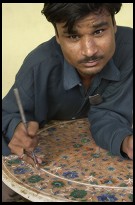
Nikon D1
by Philip Greenspun; created March 2001
Site Home : Photography : Nikon D1
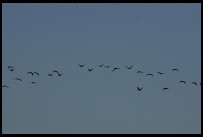 Little black
spots are appearing at the top of every photo (see image at right). A visit to
the Nikon Web site to find the manual for the D1 single-lens-reflex camera
reveals that, although they distribute the manual in PDF form on CD-ROM, they've
not put it on the Web. Fortunately I'd had the foresight to stow away a hardcopy
of the 128-page book. Page 112: "The charged-coupled device (CCD) that serves as
the D1's picture element is fitted with a low-pass filter to prevent
moiré. While this filter prevents dirt from getting onto the CCD, any dirt
or dust that finds its way onto the filter may, depending on shooting conditions,
appear in photographs taken with the camera. In this case you will need to clean
the filter."
Little black
spots are appearing at the top of every photo (see image at right). A visit to
the Nikon Web site to find the manual for the D1 single-lens-reflex camera
reveals that, although they distribute the manual in PDF form on CD-ROM, they've
not put it on the Web. Fortunately I'd had the foresight to stow away a hardcopy
of the 128-page book. Page 112: "The charged-coupled device (CCD) that serves as
the D1's picture element is fitted with a low-pass filter to prevent
moiré. While this filter prevents dirt from getting onto the CCD, any dirt
or dust that finds its way onto the filter may, depending on shooting conditions,
appear in photographs taken with the camera. In this case you will need to clean
the filter."
The manual recommends testing by photographing "an evenly-colored, white object, such as a clean white-colored wall" and then viewing the photographs on a computer. No problem. If there are spots, simply "Raise the camera mirror ... Note that the EH-4 AC adapter (available separately) is required to perform this operation. If you do not have an AC adapter, you will need to take the camera to a Nikon-authorized service center for cleaning."
Hmmm... there doesn't seem to be an EH-4 AC adapter in the camera bag. Back to the Nikon Web site to look for authorized service centers. The most important links are unavailable. Their servers are down. Twenty-four hours later, the server with the "Contact (Worldwide Network)" page is back up. Many countries are listed. India is not one of them. Oh yes, I'm in Agra, India, home of the Taj Mahal and more than 2 million people but no fancy camera shops. Google.com eventually digs up the Nikon importer for India. It is in Delhi, the capital. That's only a four-hour drive away. Turns out that they did have an EH-4 AC adapter and have cleaned out a few D1s but they sold their adapter. I set the camera to manual exposure mode, set the shutter speed to B, turn it upside down and blow into it. The spots are still there and will grace every subsequent photo taken in India. This is how Adobe sells so many copies of PhotoShop!
Important Lesson: if you're going to rely on a digital single-lens reflex camera with interchangeable lenses, dust will get into the imaging path. And it will stay there. You're not rolling a new sensor past the shutter with every exposure as with a film camera. So you'd better have some clear plan for what to do when the dust comes to visit. A backup body is probably essential, though the $3800 price of the D1 and its weight and bulk (similar to a Nikon F5) may discourage you. Canned air would be good to have. The optional AC adapter would also be a good thing to have in the case of the D1. If you can't or won't plan for this eventuality, it might be better to use a completely sealed single-lens reflex such as the the Olympus E-10.
Now on to the review...
 The Nikon D1 is a good
digital camera for photographers who want creative control and are already
invested in the Nikon F lens system. As noted above, the camera is heavy and
bulky, very similar to a Nikon F5.
The Nikon D1 is a good
digital camera for photographers who want creative control and are already
invested in the Nikon F lens system. As noted above, the camera is heavy and
bulky, very similar to a Nikon F5.
The camera's 15.6x23.7mm CCD image sensor is smaller than the standard 24x36mm frame of a 35mm camera. Thus the image that you see in the viewfinder and on the flash card is magnified 1.5X, i.e., a 50mm normal lens becomes an 75mm short portrait lens, the popular Nikon 17-35/2.8L zoom becomes 25-52mm, and a 300/2.8 supertelephoto becomes a 450mm lens.
The viewfinder is wonderful for an eyeglass wearer, with a lot of eye relief in the Nikon "high-eyepoint" tradition. You'll be able to see the entire image and the LCD display just underneath.
This is a 2.66 megapixel camera, producing an image 2000x1312 in size. The images are 8 bits deep when producing standard JPEGs (1.3 MB each), 12 bits deep when storing RAW images (4 MB each). Resolution isn't everything; the raw pixels from the D1 are much higher quality than the raw pixels from a cheap 2.6 megapixel point-and-shoot-style digital camera.
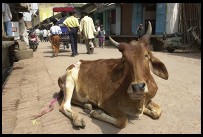 Contrasty scenes quickly
overwhelm the standard 8 bits of the JPEGs. At right, for example, is a snapshot
taken on a typical day in Brindavan, where Lord Krishna once lived as a humble
cowherd. Notice that exposing for the (sunlit) cow resulted in the pedestrian's
(sunlit) shirts having blown out highlights. The D1's default mode is to adjust
contrast based on the matrix meter and in fact here it has probably chosen the
lowest contrast possible because of the dark shadow area right above the cow's
head. But even if you are able to remember that setting Custom Function 24 to "2"
will force the camera into low contrast mode you'll find that any scene lit by
direct sunlight will need to be stored in RAW mode. Unfortunately the RAW images
have to be manually processed with
Contrasty scenes quickly
overwhelm the standard 8 bits of the JPEGs. At right, for example, is a snapshot
taken on a typical day in Brindavan, where Lord Krishna once lived as a humble
cowherd. Notice that exposing for the (sunlit) cow resulted in the pedestrian's
(sunlit) shirts having blown out highlights. The D1's default mode is to adjust
contrast based on the matrix meter and in fact here it has probably chosen the
lowest contrast possible because of the dark shadow area right above the cow's
head. But even if you are able to remember that setting Custom Function 24 to "2"
will force the camera into low contrast mode you'll find that any scene lit by
direct sunlight will need to be stored in RAW mode. Unfortunately the RAW images
have to be manually processed with
 Nikon-supplied software,
whereas JPEGs can be batch-processed with ImageMagick (the way that I've done
roughly 10,000 or so images here; see
http://philip.greenspun.com/panda/images
for background on this subject). Below is another Brindavan scene, that suffers
from the 8-bit limitation of the JPEG. If you'd taken this scene with color
negative film, a machine print might look similar to what you see below but a
custom print or a little work in Adobe PhotoShop would be able to restore the the
lost detail in the foreground newspapers, for example. If you originate 8-bit
JPEGs in a digital camera, though, the detail is lost forever.
Nikon-supplied software,
whereas JPEGs can be batch-processed with ImageMagick (the way that I've done
roughly 10,000 or so images here; see
http://philip.greenspun.com/panda/images
for background on this subject). Below is another Brindavan scene, that suffers
from the 8-bit limitation of the JPEG. If you'd taken this scene with color
negative film, a machine print might look similar to what you see below but a
custom print or a little work in Adobe PhotoShop would be able to restore the the
lost detail in the foreground newspapers, for example. If you originate 8-bit
JPEGs in a digital camera, though, the detail is lost forever.
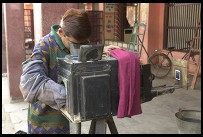 If you
wanted a camera with lots of buttons, switches, and dials, the D1 is for you!
Nikon carefully preserved every button from one of their film SLRs and then added
lots more buttons and menus to control the digital aspects of photography.
If you
wanted a camera with lots of buttons, switches, and dials, the D1 is for you!
Nikon carefully preserved every button from one of their film SLRs and then added
lots more buttons and menus to control the digital aspects of photography.
The D1 basically doesn't want you using the aperture ring on any modern (CPU) Nikon lens. You are supposed to set the lens ring to the minimum aperture and then use one of the two control dials on the camera to set aperture. If you're accustomed to Canon EOS, where the lenses don't have aperture rings, you probably won't like having a vestigial aperture ring cluttering the lens. It just gives the photographer another way to fail. You're holding the camera in your hand, waiting for the right moment. You press the shutter release and the camera flashes "fEE" at you because the aperture ring has gotten knocked off its minimum setting. This is also annoying because actually the physical aperture ring on the lens might be an ergonomically superior control to the dials on the body, which don't fall as naturally under the finger and thumb as with Canon EOS bodies. This becomes a major annoyance. Even after taking 1000 pictures or so, it never felt natural to operate the control dials.
The D1 facilitates simultaneous use of manual and auto focus with AF-S lenses. Using Custom Function 4, you can shift autofocus from the shutter release to the AF-ON button on the rear of the body, which falls very naturally underneath your right thumb. If you have a lens with a "silent wave" motor (Nikon's answer to Canon USM), you can leave the lens in AF mode for AF or MF. When you want to focus, turn the ring on the lens or push the button under your thumb. You make a conscious decision. If your subject stays at the same distance and you don't feel the need to refocus, you need not. If CF 4 is set, the camera will never run off wildly and unexpectedly to hunt for focus.
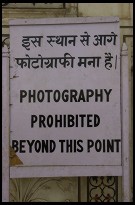 The D1 is modal. If you are sitting in a cafe and want to review some pictures
that you took in the morning, switch the top left control dial from "single shot"
to "play" mode. Your old pictures will start appearing on the LCD screen. Set the
camera down and have some soup. Is a French guy riding past on his bicycle with
baguettes clamped in the back rack? Grab the camera and press the shutter
release. Nothing happens. The LCD in the viewfinder? Blank. Check the camera
on/off switch. It is on. What's wrong? You forgot to press in the little release
button and switch the top left control dial to "single shot". The
Canon D30's modeless operation is much more
user-friendly.
The D1 is modal. If you are sitting in a cafe and want to review some pictures
that you took in the morning, switch the top left control dial from "single shot"
to "play" mode. Your old pictures will start appearing on the LCD screen. Set the
camera down and have some soup. Is a French guy riding past on his bicycle with
baguettes clamped in the back rack? Grab the camera and press the shutter
release. Nothing happens. The LCD in the viewfinder? Blank. Check the camera
on/off switch. It is on. What's wrong? You forgot to press in the little release
button and switch the top left control dial to "single shot". The
Canon D30's modeless operation is much more
user-friendly.
Setting custom functions is an appalling experience. The back of the camera is equipped with a huge bit-mapped display. The interior of the camera is filled with computer power. How do you set custom functions? Is there a nice menu that you can navigate through on the rear LCD display? No. You have to carry around the 128-page reference manual that will tell you what "Custom Function 24" is or what settings 0, 1, 2 and 3 mean for CF 24. The function and its setting are displayed on a little tiny dedicated alphanumeric LCD just below the big LCD screen. It is almost as through separate engineering groups were assigned to put in the image display screen and the custom function logic. So each group added a display and buttons to the camera. The body is sufficiently huge that there is plenty of room for extra displays and buttons and therefore nobody ever caught the fact that "Hey, we've got a huge display and a menu system already; how often do people really need to change whether or not the LCD illuminator turns on when any button is pressed or only when the on/off switch is turned to the lightbulb setting? And wouldn't they rather read English text on the screen than have to memorize numbers or carry a 128-page manual?"
There is a dedicated depth-of-field preview button to the right of the lensmount. Engaging depth-of-field preview makes the Mother of All Clicking Noises. Missing features? If you're used to a point-and-shoot style digital camera, you'll miss the real-time image preview on the rear LCD monitor. Don't go looking for the button to turn this on. Remember that this is a single-lens reflex. If you can see the image through the viewfinder, that means there is a mirror in front of the sensor. Only at the instant of exposure does the mirror flip up and permit light to flow through to the shutter/sensor system. This lack of continuous sensing precludes the "panoramic assist" mode that is standard on point-and-shoot style digital cameras. You can still stitch together photos after the fact but you'll probably have to use a tripod to keep the horizon level.
Vertical image creation is made easier by the inclusion of a second shutter release and duplicate main command dial on top of the battery pack.
Bottom line: probably the most complex camera ever produced. Nikon makes a bad situation worse by not putting the manual in HTML format on its Web site. You can download a huge PDF file from some kind souls in Europe who copied it off Nikon's CD-ROM, but try reviewing that in an Internet cafe when in the middle of a photo expedition.
Unlike competitors such as the Canon EOS D30, the Nikon D1 does not include an on-camera flash. From an artistic point of view, this isn't a big problem. Unless you count Weegee not too many great images are lit by on-camera flash. However, an on-camera flash is a much more useful device with a digital camera than with a film camera. If you're creating 8-bits-per-color (24-bit total) JPEG images for the Web it is very easy to exceed the contrast range of the camera, even if you've remembered to set Custom Function 24 to 2 (low contrast). An on-camera flash used as a fill light can balance out a scene's contrast to bring it within the capabilities of the 8-bit JPEG format. Second, the fact that a digital camera can be set in an emergency to ISO 800 or ISO 1600 means that an on-camera flash may offer a substantial range.
The full range of Nikon off-camera flash cords and flash control systems work with the D1. Sadly, you don't get even basic through-the-lens flash exposure metering with older flashes. You basically must buy the SB-28DX to get the features that you'd expect.
 Use Custom Function 13 so that you
can set exposure compensation with the sub-command dial, rather than having to
push a button and turn the main dial simultaneous. For tripod photography, use
Custom Function 16 to set the self-timer duration to 2 seconds. Thus it is
possible to use the self-timer as a pseudo cable release.
Use Custom Function 13 so that you
can set exposure compensation with the sub-command dial, rather than having to
push a button and turn the main dial simultaneous. For tripod photography, use
Custom Function 16 to set the self-timer duration to 2 seconds. Thus it is
possible to use the self-timer as a pseudo cable release.
Carry plenty of spare batteries. The D1's batteries are enormous and heavy. The camera lacks a built-in flash. Nonetheless you'll be lucky to get 100 images out of one Ni-MH battery pack before recharging.
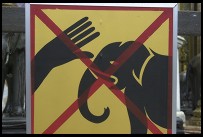 My
biggest complaint with the Nikon D1 was lost photos. When set to "single-shot
mode" you can't take a picture for several seconds immediately following an
exposure. Suppose that you snap a photo of your friend. Right after that first
exposure your friend's expression relaxes. Wow! The perfect picture. Right there
in the viewfinder. You press and you press and you press the shutter release.
Nothing happens. The camera is busy writing the previous (mediocre) photo to the
flash card or Microdrive.It was equally slow with both media types that I tested;
see http://www.robgalbraith.com/reports/2001_02_17_compactflash.html
for data showing that a 1.3 MB high-quality JPEG should take about 3 seconds with
a SanDisk flashcard or IBM Microdrive; a little over 1 second with a Lexar
flashcard. It is unclear why the D1 is such an uncooperative companion in this
respect. As noted below the camera has a substantial buffer RAM for sequential
exposures in "continuous mode". So you'd think that with a little bit of extra
programming smarts it could write a new photo to its buffer while saving an old
one onto the flashcard.
My
biggest complaint with the Nikon D1 was lost photos. When set to "single-shot
mode" you can't take a picture for several seconds immediately following an
exposure. Suppose that you snap a photo of your friend. Right after that first
exposure your friend's expression relaxes. Wow! The perfect picture. Right there
in the viewfinder. You press and you press and you press the shutter release.
Nothing happens. The camera is busy writing the previous (mediocre) photo to the
flash card or Microdrive.It was equally slow with both media types that I tested;
see http://www.robgalbraith.com/reports/2001_02_17_compactflash.html
for data showing that a 1.3 MB high-quality JPEG should take about 3 seconds with
a SanDisk flashcard or IBM Microdrive; a little over 1 second with a Lexar
flashcard. It is unclear why the D1 is such an uncooperative companion in this
respect. As noted below the camera has a substantial buffer RAM for sequential
exposures in "continuous mode". So you'd think that with a little bit of extra
programming smarts it could write a new photo to its buffer while saving an old
one onto the flashcard.
One way to deal with the "camera locked writing last photo" problem is to keep the D1 in "continuous mode" all the time. This divorces the capturing of photos from the writing out of photos. So the shutter will release when you want. Unfortunately, unless you have an incredibly light touch the shutter will also release when you don't want. You'll end up having to wade through a lot of duplicates at editing time. Remember that the D1's continuous mode rips away at 4.5 fps!
A life-wasting problem with the Nikon D1 is that it does not understand when it is being held vertically. Thus all the portrait-format JPEGs, once transferred onto a computer, are incorrectly oriented. You have to right click the mouse on every picture that you exposed vertically and then select "rotate 90 degrees left". With most image editing software this is also a quality-wasting problem as the image is de-JPEGed and re-JPEGed (though actually it is possible to reorient a JPEG without loss). The actual operation takes a few (long) seconds on a 700 MHz Pentium. There are plenty of consumer-priced devices, e.g., the new Minolta Maxxum 7, that contain small mercury switches to sense orientation with respect to gravity. Every digital camera should have the ability to make an educated guess as to the correct ultimate JPEG orientation.
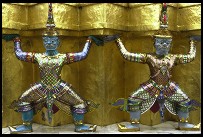 If you have a big Nikon
lens system or are a photojournalist, the D1 is worth considering. If you don't
own any Nikon products, you should probably consider
If you have a big Nikon
lens system or are a photojournalist, the D1 is worth considering. If you don't
own any Nikon products, you should probably consider
One area where the D1 is better than any other digital camera is speed for repeated frames. Sports photographers and photojournalists will love the fact that the camera can store 21 consecutive images in its internal memory. These may be taken at 4.5 frames per second.
In spring 2001, Nikon replaced the D1 with two new models. The D1x offers high resolution: a 5.4 megapixel sensor. The D1H is designed for sports photographers and offers the same resolution as the D1 but a huge memory for sequential images and 5 frames-per-second capture rate. We're trying to get hold of a D1x for review.
A few favorites from Bangkok and environs ...
Some from in and around Agra ...
A handful from Mumbai... (all set to "low contrast"; just about all of the others on this page were taken at "auto contrast" where the D1 is supposed to figure out what to do from the matrix meter)
Text and photos copyright 2001 Philip Greenspun.